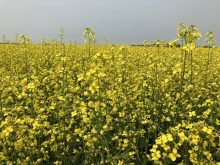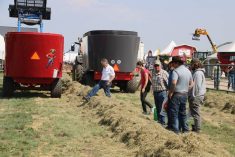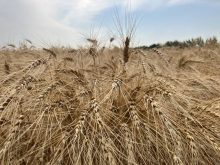They’re not calling it a drought, but crop specialists in Manitoba say hot, humid, dry weather will serve up a slightly below average crop to farmers in most parts of the province this year.
Farmers here don’t have as much to complain about as their neighbors in Saskatchewan, but southwestern Manitoba producers haven’t had measurable rain in over three weeks. Like their crops, they’re feeling the stress.
“We never subscribed to the theory that we were looking at a bumper crop,” said provincial crop specialist Dave Campbell.
Read Also

Supreme Court gives thumbs-up emoji case the thumbs down
Saskatchewan farmer wanted to appeal the court decision that a thumbs-up emoji served as a signature to a grain delivery contract.
The worry is that hot weather could lead to blossom abortion in canola and badly burned cereal crops.
Where spotty thunderstorms have struck, near Boissevain in the west and around Carman in central Manitoba, results are equally damaging.
“The quickie thunderstorms have left us with quite a variable picture out there.”
Heavy rain drowns crops
Flash thunderstorms were common in pockets from the top escarpment of the Red River Valley west to the Saskatchewan border and north as far as Dauphin.
Heavy rain in spots around Carman drowned some pulse crops and is leading to tuber rot in potatoes.
“They don’t like water-logged soils,” Campbell said.
But pea and bean crops have suffered the most from excessive moisture, said Manitoba plant pathologist Gary Platford. Heavy rains in July led to root rot in many pea crops.
“Some areas right around the river never did dry out that well,” he said.
Where plants aren’t burning up from heat or drowning in excess moisture, their seeds are struggling to survive a widespread attack of fusarium head blight.
Fusarium also found
Traces of fusarium in wheat and barley crops near Killarney and Boissevain were an unwelcome surprise this year. Fusarium affects the heads at flowering. The diseased seeds are lighter and most will blow out in the combine.
“It really isn’t a case of the crop being written off,” Platford said. “We expect the main impact will be in yield reduction rather than the quality.”
Andrej Tekauz, a disease specialist with Agriculture Canada’s cereal research centre in Winnipeg, said fusarium head blight is present in nearly all fields of wheat and barley in Manitoba.
Average levels for wheat are about 10 percent, and three percent for barley.
As was the case last year, fusarium will likely destroy 20 to 25 percent of the most severely hit fields in Manitoba, Tekauz said. On average, yield losses from the disease will be five to eight percent for wheat and one or two percent for barley.
Aside from the fusarium outbreak, leaf spots are a bigger problem in Manitoba this year compared to previous years.
Tan spot and net blotch have developed to severe levels in most fields, said Tekauz. Losses could reach 20 percent of grain yield.
















